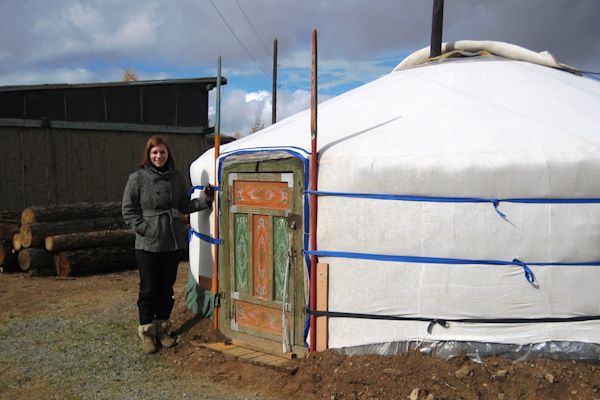Traditional Mongolian gers and the artisans who produce them
October 18, 2010
By Amber Barger, KF12, Mongolia.
If you browse Mongolian borrower profiles on Kiva.org, you’ll notice that most of them say that the borrower lives in traditional Mongolian housing named a ger, more commonly known as a yurt. Over the past few weeks, I’ve had the opportunity to visit borrowers who live in traditional gers and who work in ger-producing workshops. In addition, I have the personal experience of living in a ger for a year as a Peace Corps Volunteer.
In Mongolia many types of artisan specialties are needed in order to produce the items that make up a ger. Kiva entrepreneurs that produce ger-related items include carpenters, painters, felt-makers, welders, seamstresses, etc. The felt-makers produce the outer coverings of the ger. The welders produce the stoves that sit in the center of the ger. The carpenters produce the skeleton of the ger including wooden lattices, poles, and beams. The carpenters also produce traditional ger furniture like chests, dresser drawers, tables, and stools. The painters turn the carpentry work into beautiful pieces of brightly-colored art. The seamstresses create the inside wall hangings of the ger, plus other decorative items.
I’ve visited several small-scale furniture-producing carpenters and painters. Nasandelger is a painter who buys unfinished wooden ger products from carpenters. She paints wooden items, like chests, poles, chairs, and doors, with the traditional bright orange base color with green, blue, and white accents. Nasandelger said she sells more items in the wedding season of fall and spring than in the winter. In Mongolian tradition, when a couple is married they will buy a ger in order to live together. Check out this short video tour of Nasandelger’s painting workshop that she shares with five carpenters:
'
When I interview borrowers and ask what their future goals are, many of the borrowers say that they would like to own the land that their ger is built on, and then after that they would like to build a brick house on their land. Living in a ger is a lot of work, I know this from experience: fetching water from the well, chopping wood, keeping a fire going for 8-9 months of the year, using an outhouse, bathing in a bucket, etc. Even though some people want the stability of a brick or wooden house on their own private land, these houses, especially in the countryside, are still in the same neighborhood as the gers, which means the houses aren’t connected to central heating lines or running water.
So many borrowers I interview say that their future goal is to move out of a ger, and yet so many small business entrepreneurs are involved in producing ger products. I hope Mongolia can find a balance between its traditional past and likely booming future.
—-
Read a post by a previous Kiva Fellow about Mongolian gers.
Join the Mongolia leading team on Kiva.org!
Amber Barger is currently serving as a Kiva Fellow in Mongolia. She has lived for the past two years in rural Mongolia as a community economic development Peace Corps Volunteer. Along with her Kiva Fellowship, she is extending a third year with the Peace Corps as a Peace Corps Volunteer Leader.
PREVIOUS ARTICLE
Zaporozhye Celebrates Its Birthday! →NEXT ARTICLE
Nicaragua by any means necessary →















